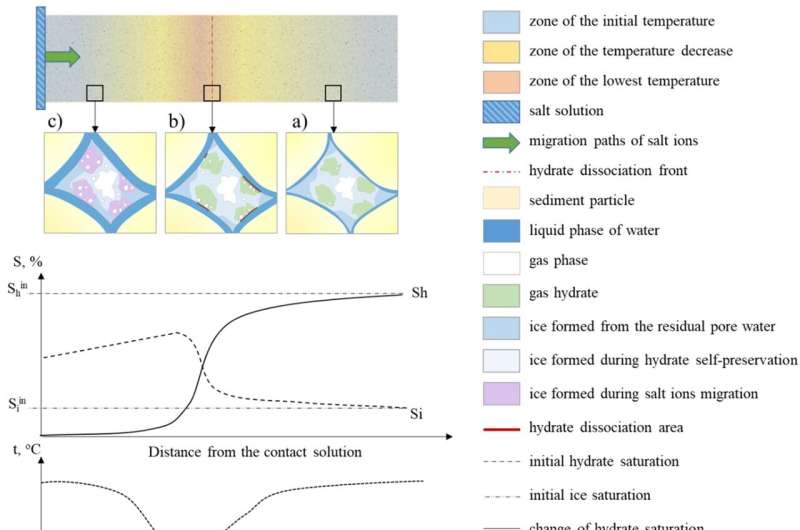Researchers reveal how salt may play into climate warming

A team of Skoltech researchers has published a series of three papers dealing with various aspects of how salt from the ocean water and other salts penetrate into frozen soil that contains gas hydrates—icelike crystals composed of water and gas, mostly methane. This so-called salt migration affects the rate at which permafrost melts as global warming advances. Taking that process into account is therefore necessary for accurate climate change modeling. The research findings are reported in papers dated June 27 and July 9 in the journal Geosciences, and in the July 5 paper in Energy & Fuels.
"The currently used mathematical models of natural and human-caused permafrost degradation tend to neglect salt migration," Leading Research Scientist Evgeny Chuvilin of Skoltech, the project's principal investigator, commented. "However, both the natural intake of ocean salt and the chemical solutions used in well drilling lower the temperature at which permafrost starts to melt, accelerating its degradation. So salt migration has to be accounted for, and this is precisely why we are studying it in minute detail."
One of the three papers examines how the pressure exerted on frozen soil during salt migration affects the degradation of hydrate-free and hydrate-saturated permafrost (both types also contain ice and residual unfrozen water). Experiments with model soil, which controlled the other factors impacting salt ion transfer, indicated that rising pressure had no significant effect on salt migration in—and the degradation rate of—hydrate-free permafrost. However, once the soil was saturated with hydrates, their presence affected salt diffusion, and such permafrost turned out to be highly sensitive to pressure variations. Namely, lowering the pressure led to faster salt migration, and stepping up the pressure diminished the ion transfer rate, slowing down thawing.
In another study, the team considered three further factors potentially affecting the same process: ambient temperature, salt concentration, and the chemical composition of the salt. The experiment showed that at progressively lower temperatures (only the subzero range was considered) salt migration was increasingly retarded. While this effect was generally to be expected, this is the first time its scope has been quantitatively estimated on frozen soil samples. Also, at higher salt concentrations, it took the ions less time to penetrate into the soil. As for the salt composition, migration was more active for chlorides than sulfides, and was also observed to slow down in the following progression, starting with the most "mobile" metal ion magnesium, down to sodium, calcium, and finally potassium at the slower end of the spectrum.
Finally, the third piece of research involved surrounding the cubic sample with a number of temperature sensors to detect how the spatial distribution of temperature in the frozen soil changed due to salt migration. As the experiment proceeded, a nonuniform temperature field emerged. The reason for this is that the regions where salt has already penetrated begin thawing earlier, and thawing consumes heat. This effect is several times more pronounced for the hydrate-saturated permafrost, which has to do with gas hydrate decomposition under salt migration. The cooling effect sets in faster, and the original temperature field takes longer to recover.
"The findings of our experimental modeling offer a new perspective on the processes involved in intrapermafrost gas hydrate dissociation under the conditions of salt migration and the contribution of salt migration to permafrost degradation in the face of the climate change on Earth," Chuvilin concluded.
More information: Evgeny Chuvilin et al, Temperature Variation during Salt Migration in Frozen Hydrate-Bearing Sediments: Experimental Modeling, Geosciences (2022). DOI: 10.3390/geosciences12070261
Evgeny Chuvilin et al, Migration of Salt Ions in Frozen Hydrate-Saturated Sediments: Temperature and Chemistry Constraints, Geosciences (2022). DOI: 10.3390/geosciences12070276
Evgeny Chuvilin et al, Pressure Influence on Salt Migration in Frozen Hydrate-Saturated Sediments: Experimental Modeling, Energy & Fuels (2022). DOI: 10.1021/acs.energyfuels.2c01282
Provided by Skolkovo Institute of Science and Technology


















